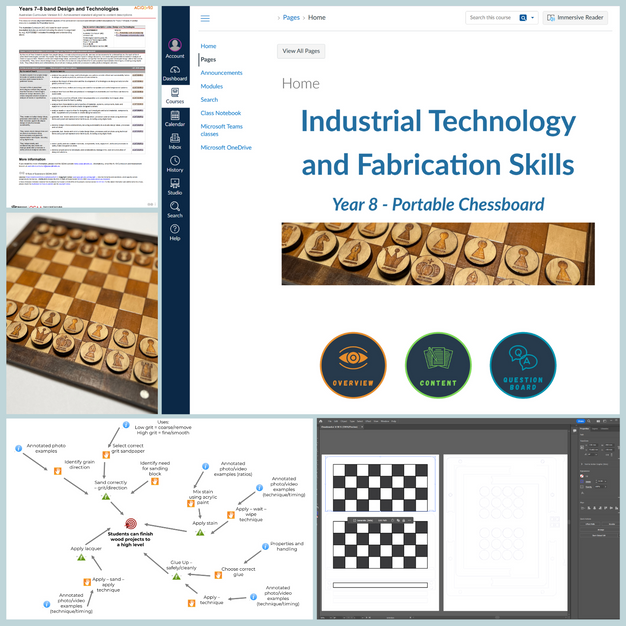"They’re already hard to find, and it’s getting harder"
On top of a general shortage of teachers in Australia, experienced specialist teachers like workshop skilled Technology teachers are in even more short supply.
Having began using online learning tools pre-COVID, the school learning culture enabled the use of a blended learning solution.
This course centred around the production of a plywood portable chess set using laser cutting and finished with traditional woodworking techniques.

Overview
This course was developed with the intention of being a turn-key product which almost any teacher would be able to deliver to a Year 7 and 8 cohort regardless of background knowledge.
This would therefore allow the limited number of experienced Industrial Arts teachers to be allocated to older students requiring more specialised instruction while still providing meaningful workshop learning to younger students.
The course was built in Canvas LMS using SCORM packages to allow face to face delivery, while also accommodating absent students with online learning materials.
Audience: High school students – Year 7 & 8 regardless of previous experience with woodworking
Tools: Articulate Storyline, Adobe Illustrator, Adobe Photoshop, Canvas LMS
Process
The project was created using the following methodology:
- Learning Needs Assessment
- Action Mapping
- Sketches & Wireframes
- Asset Creation
- Final Project
Learning Needs Assessment
Working with specialist workshop teachers and curriculum alignment experts, along with my own educational experience, we identified the specific skills and knowledge that could be learned and assessed though a project like this. Then we considered current issues stopping the learners from achieving success in this area and how we could overcome this.
The learners themselves were also considered as chess is a popular lunchtime activity with this school and therefore the learners will have a more emotional connection to the project and increase the likelihood of succeeding in the project.
Action Mapping
This project involved learners being competent at a large range of skills, from digital creation to traditional woodwork skills. After discussing these with experienced practitioners a number of key skills were identified which formed the focus the learning.
Essential skills were targeted through action maps to ensure that there was a clear connection between the learning activities and the required outcome.

Sketches & Wireframes
Learning a range of skills can prove to be difficult for anyone, but an infinitely diverse range of learners in the early years of high school is even more so. The use of instructional videos formed a key component of the course and to account for different learner needs it was imperative to develop a layout that was appropriate. The use of sketches and wireframes were crucial in the development of these layouts and organisation.
The video learning sketch below was the final iteration where I incorporated a number of techniques to cover a wide range of learner needs.

Asset Creation
A key component to this project was the creation of video tutorials to cover skill development, where these tutorials were broken into logical chunks to help manage cognitive load and provide a checkpoint for progressing to the next step.
However there was also a need for some background in the materials being used to ensure their safe and efficient use. The style of these content learning activities does not remain constant across all topics by design. The intention is to allow the teacher giving instruction alongside to vary their delivery and the avoid losing engagement in the lesson.
Final Project
These individual components were then compiled into an LMS to serve as a coherent course. There were several goals with this:
- Contain all resources for any teacher taking the class as an instructor, regardless of their subject knowledge
- Allow for remote learning if necessary
- Allow the course to be repeated in subsequent semesters with few adjustments
- Allow learning from home to account for students who were absent from lessons
- Meet assessment, reporting and record keeping requirements of the school system
In the end, the project resulted in an LMS based course that can be rolled out again and again, allowing students to experience Design & Technology learning despite the shortage of qualified specialist teachers.